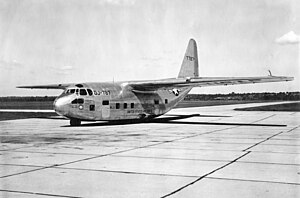Chase CG-20
| Chase CG-20 | |
|---|---|
 Prototype XG-20 |
|
| Type: | Glider |
| Design country: | |
| Manufacturer: | |
| First flight: |
1950 |
| Commissioning: |
No |
| Production time: |
was modified as a Fairchild C-123 provider |
| Number of pieces: |
2 |
The Chase CG-20 was the largest glider that as a glider ever in the United States was developed in the late 1940s. The term CG stand for C argo G lider.
history
After the end of World War II, the United States Army Air Forces (USAAF) commissioned various aviation companies to develop large cargo gliders for transporting troops and materials. The new versions were intended to replace the smaller, wooden types (for example the Waco CG-4A ) that were used in World War II. The new cargo gliders should be all-metal airplanes.
USAAF signed a five-year development program with Chase Aircraft Company of Trenton, New Jersey . In August 1946, Chase designer Michael Stroukoff introduced the model called the XCG-18A. The XCG-18 could not achieve the required payload and Chase then designed the final model called the XG-20.
The XG-20, built in 1948, was the largest glider ever built in the USA after the USAF was founded and at the same time the last cargo glider to be built for the US military. The second prototype had its maiden flight in April 1950. After that, basic flight tests were carried out at Eglin Air Force Base in Florida .
description
The XG-20 is a shoulder- wing aircraft with retractable tricycle landing gear. It had a span of around 33 meters and was equipped with an auxiliary power unit for the hydraulics, which supplied the landing gear, rudder and flaps with the required pressure. The bow of the XG-20 has been reinforced in the front section in order to ensure the load distribution of the towing connection to the tow plane and to guarantee optimal protection for the pilots in the event of a hard landing. An innovative configuration of the rear fuselage with an integrated hydraulic loading ramp made it possible to easily load vehicles from the rear and accelerated the loading and unloading times for both cargo and troop loading.
Further development
Although there were no apparent flaws in the testing program, the Air Force prematurely terminated its collaboration with the Chase Aircraft Company and the XG-20 project was canceled.
Michael Stroukoff modified the glider with two Pratt & Whitney R-2800-23 radial engines, each with an output of 2,200 hp. This version was called the XC-123. The version then designated as XC-123A with four General Electric J47-GE-11 jet engines in double nacelles borrowed from the Boeing B-47 under the wings was the first jet-powered cargo aircraft in the United States.
The XC-123 was built from 1954 to 1970 as the Fairchild C-123 "Provider" in a series of 307 copies. She was in service with the American Air Force from 1955 and later also with the American Coast Guard .
The twin-engine transport aircraft was specially modified for use in the Vietnam War.
Technical specifications
- Crew: 3
- Length: 23.50 m
- Span: 33.53 m
- Height: 10.31 m
- Wing area: 113.6 m²
- Surface profile: NACA 23017
- Max. Take-off weight: 31,750 kg, limited to around 18,000 kg due to the lack of a suitable tow plane. The curb weight is not known.
literature
- John M. Andrade: US Military Aircraft Designations and Serials since 1909 . Midland Counties Publications, Leicester 1979, ISBN 0-904597-22-9 (English).
Individual evidence
- ^ Bill Gunston: The Encyclopedia of the World's Air Power . Crescent Books, New York 1980, ISBN 0-517-53754-0 , pp. 170 (English).


